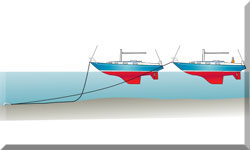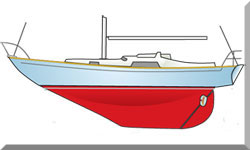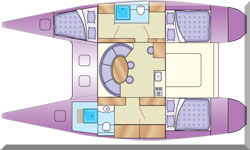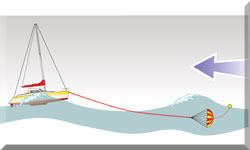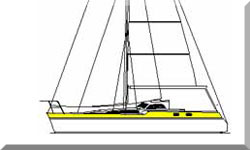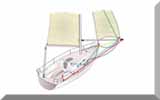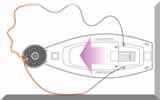- Home
- Electrical Systems
- Marine Solar Panel
Marine Solar Panels: Pretty Much Everything You Need to Know
Modern sailboats are packed with gadgets and gizmos that need electricity. From navigation systems and autopilots to fridges and entertainment systems, all that tech requires a reliable and sustainable energy source. Installing marine solar panels on your sailboat isn't just a smart move for keeping everything powered up; it's also a step toward eco-friendly sailing.
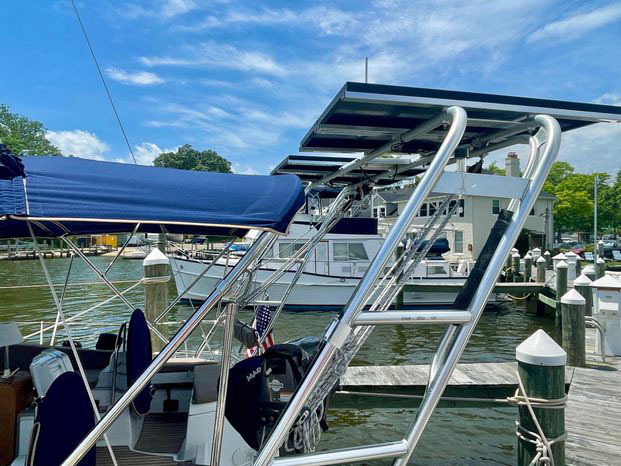 Atop the gantry is a popular location for rigid solar panels...
Atop the gantry is a popular location for rigid solar panels...
Factors Affecting the Performance of a Marine Solar Panel
A number of factors affect their performance, or from another point of view, just one—the sun:
- Angle of incidence of the sun's rays - This of course depends on season and latitude. At the equator the sun is high in the sky for much of the day, so excellent performance can be expected. In high latitudes, with the sun low in the sky, performance will be much reduced;
- Period of exposure - At the equator, cloud cover accepted, you can feel entitled to 12 hours of it. At high latitudes in the summer, rather more but less intense. But in these latitudes in the winter, you shouldn't expect much from your solar panels at all;
- Temperature - As temperature rises output falls. Output is normally quoted at 25°C. In the sun-drenched tropics their surface temperature could easily be double that, and were it not for the cooling trade winds, their output would be seriously impaired;
- Cloud cover - Less is best. No surprises there, but modern panels no longer need bucketfuls of direct sunlight.
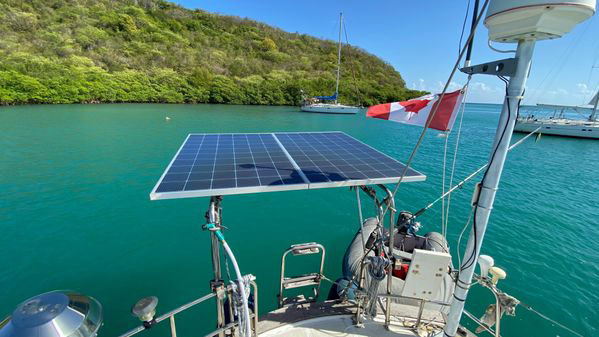 as is on the dinghy davits...
as is on the dinghy davits...
The Technology behind a Marine Solar Panel
A photovoltaic (PV) solar cell consist of two layers of silicon-based laminates constructed as a 'semiconductor' in which one of the layers is electrically positive and the other negative. When subjected to the sun's rays, the photovoltaic activity between the two produces an electrical current.
The principle's not new, having been unearthed by the French scientist Henri Becquerel (1852 - 1908), who also won the Nobel Prize for bringing radioactivity to the world's attention.
But it's all moved on a bit since then so, if you're thinking about installing or upgrading your existing solar panels with the latest technology, here's what you need to be thinking about...
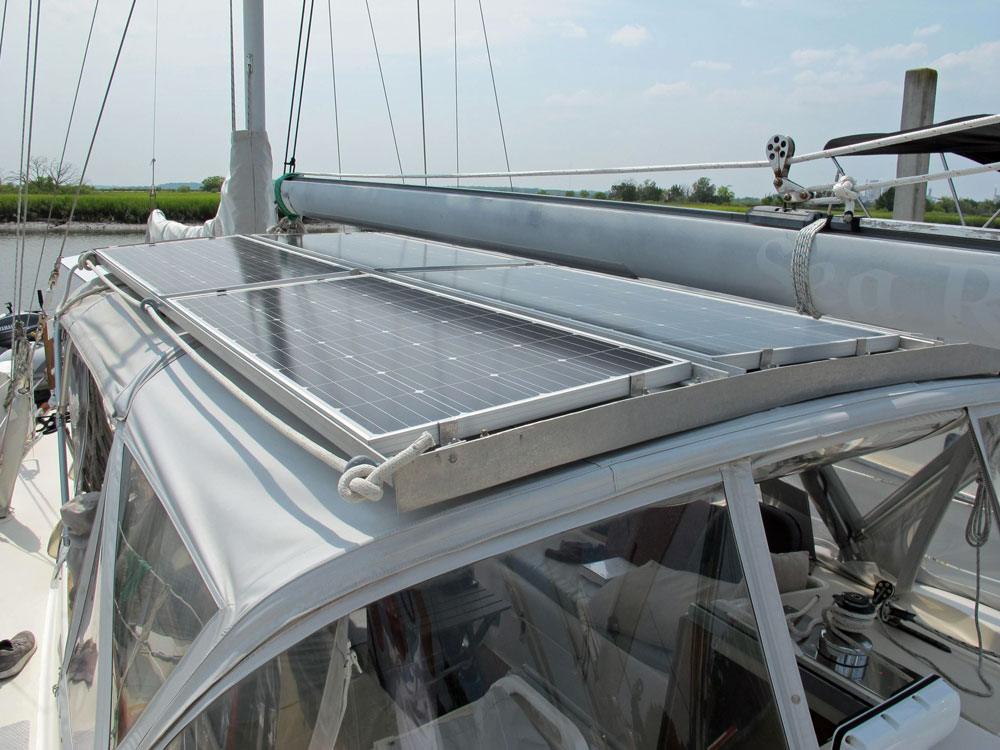 In this location, solar panel performance will be reduced by shadows from the mast and boom
In this location, solar panel performance will be reduced by shadows from the mast and boom
Assessing Your Energy Needs
Before you jump into installing solar panels, it's important to know how much energy your boat actually uses. Start by making a list of all the electrical devices on board—think GPS, lights, fridge, radio, everything. Then, estimate how many watt-hours each device consumes per day. Adding up these numbers gives you a solid idea of your total daily energy consumption.
Also, pay attention to when you use the most power. Are evenings when you have all the lights and electronics on? Knowing your peak usage times helps ensure your solar setup can handle your needs without any surprises.
Now, let's talk about cutting down on energy use. Switching to LED lighting is a simple way to reduce power consumption—they use less energy and last longer. Opting for energy-efficient appliances designed for marine use can make a big difference too. And developing habits like turning off devices when they're not in use can help lower your overall energy needs. The less power you use, the smaller (and more cost-effective) your solar system can be.
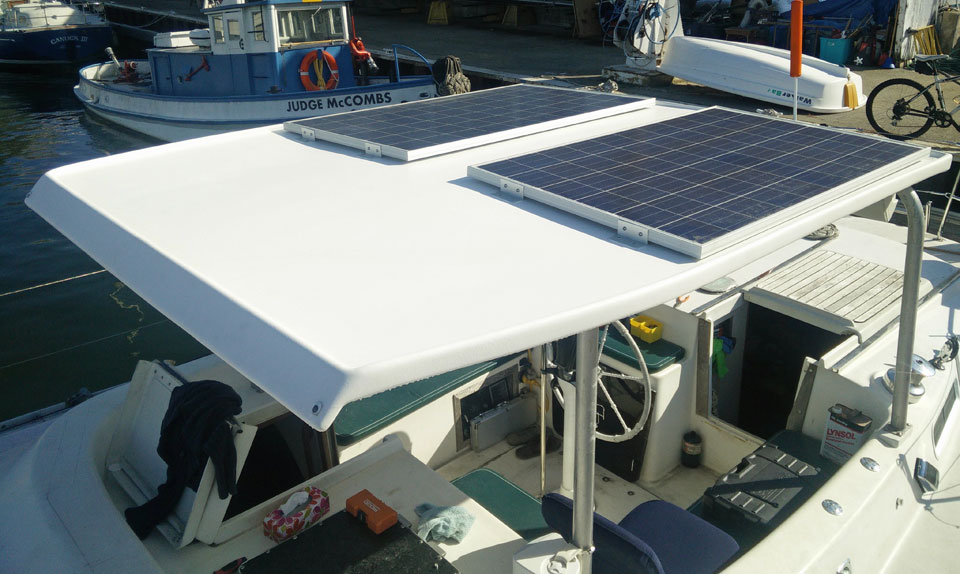 or on a hard bimini...
or on a hard bimini...
Advancements in Solar Panel Technology
Solar technology has come a long way, and there are some exciting advancements that are perfect for sailboats.
High-Efficiency Solar Cells
- Monocrystalline Panels: These are made from pure silicon, making them super efficient and space-saving—a big plus when deck space is limited. Plus, they have a sleek, uniform look that can complement your boat's style.
- PERC Technology (Passivated Emitter Rear Cell): Panels with PERC tech have an extra layer that reflects unused sunlight back into the cell, boosting efficiency. This is especially handy on cloudy days or during sunrise and sunset.
- Heterojunction (HJT) Cells: These combine different types of silicon to perform better in hot temperatures, making them ideal if you sail in warmer climates.
Flexible and Semi-Flexible Panels
Flexible panels can bend to fit the curves of your deck or bimini top. They're lightweight and durable, designed to handle the vibrations and movements of a boat. Plus, you can attach them directly to surfaces without heavy mounting equipment.
Bifacial Solar Panels
These panels absorb light from both the front and back, increasing the total energy they generate. If you mount them over reflective surfaces—like the water or a light-colored deck—they can capture even more sunlight.
 or maybe flexible panels on a soft bimini
or maybe flexible panels on a soft bimini
Innovations in Solar Panel Design for Marine Use
Sailing presents unique challenges, but modern solar panels are up to the task.
Marine-Grade Durability
Panels are built with materials that resist saltwater corrosion and UV damage. They have reinforced frames and special coatings to withstand harsh sea conditions.
Integrated Solar Solutions
- Solar Cloth and Sail Integration: Imagine solar cells embedded right into your sails or canvas covers. This setup uses space efficiently without changing your boat's appearance.
- Deck-Embedded Panels: These panels sit flush with your deck, maintaining functionality and safety. Some even have textured surfaces to prevent slipping.
Lightweight Materials
Using advanced composites reduces the weight of the panels, lowering your boat's center of gravity. This can enhance stability and even improve performance.
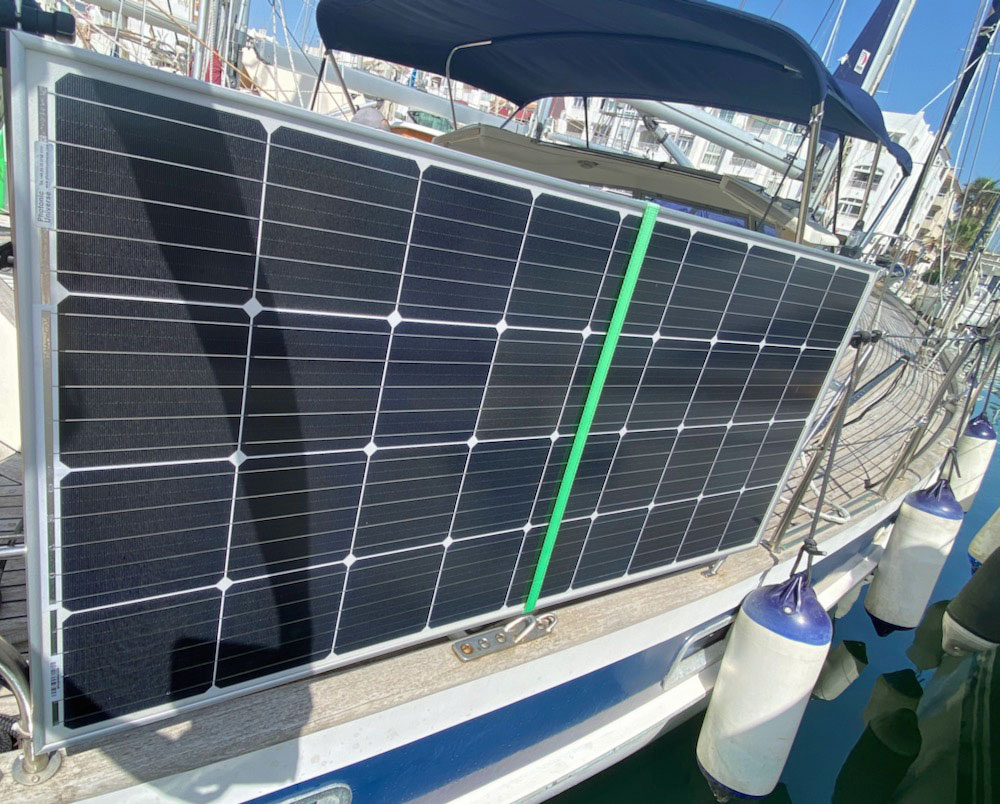 Hinged on the guard rails, these can be adjusted such that your solar panel captures the maximum amount of sunlight throughout the day.
Hinged on the guard rails, these can be adjusted such that your solar panel captures the maximum amount of sunlight throughout the day.
Future-Proofing Your Investment
You want your solar system to last for years, so consider options that can grow with your needs.
Scalability
Choose systems that allow you to add more panels or batteries down the line. Investing in inverters and controllers that can handle extra capacity means you won't have to overhaul everything if you decide to upgrade.
Smart Technology Integration
- IoT-Enabled Systems: These let you monitor energy production and consumption in real-time through apps or onboard displays. You can get remote diagnostics and even optimize performance automatically based on conditions.
Advanced Energy Storage
- Lithium Iron Phosphate (LiFePO₄) Batteries: These batteries are more efficient, charge faster, and last longer than traditional lead-acid batteries. They're also safer and lighter, which is always a bonus on a boat.
Future Compatibility
Make sure your components are compatible with upcoming technologies. Equipment that supports firmware updates or can integrate with new tech keeps your system from becoming outdated.
Installation Considerations
Proper installation is key to getting the most out of your solar panels.
Optimal Placement
Consider where the sun hits your boat throughout the day and avoid areas shaded by masts or sails. Tools or professional consultations can help you figure out the best spots for your panels.
Mounting Solutions
- Fixed Mounts: Simple and sturdy, these mounts have no moving parts and can handle rough weather.
- Adjustable Mounts: These allow you to tilt or rotate the panels to follow the sun, increasing energy capture—especially useful if you can adjust them based on the season or your location.
Electrical Infrastructure
Use marine-grade, tinned copper wiring to resist corrosion. Proper cable sizing prevents energy loss and overheating. And don't forget MPPT (Maximum Power Point Tracking) charge controllers—they optimize the energy you get from your panels.
Unless you're an experienced electrician, it's a good idea to hire a certified marine professional to handle the installation. They'll ensure everything complies with safety standards.
Regulatory and Safety Aspects
Safety should always be a priority.
Safety Protocols
Install overcurrent protection like fuses or breakers to prevent electrical overloads. Proper grounding and bonding reduce the risk of shocks and equipment damage. Regularly inspect your system for wear, corrosion, or damage.
Keep fire extinguishers accessible, and make sure everyone on board knows how to use them in case of an electrical fire.
Maintenance and Longevity
Keeping your solar panels in good shape doesn't have to be tough.
- Routine Inspections: Check for cracks, scratches, or loose connections. Ensure there's no corrosion on the wiring.
- Cleaning: Rinse panels with fresh water to remove salt and grime. Use a soft cloth to avoid scratching the surface.
- Protective Measures: Use covers when the boat's not in use for a while, and consider UV-resistant coatings if the manufacturer suggests them.
- Monitoring Performance: Keep an eye on energy production. If you notice a drop, it might be time for maintenance. Some systems offer alerts for these kinds of issues.
Conclusion
Adding solar panels to your sailboat is a smart move that boosts your independence on the water and reduces your environmental impact. By understanding your energy needs, embracing the latest solar technologies, and planning for future upgrades, you're setting yourself up for smooth sailing ahead. Plus, you're contributing to a greener planet, which benefits us all.
Marine Solar Panel Issues: Your Questions Answered...
.........................
I wrote this article using GPT-4, OpenAI’s large-scale language-generation model, as a research assistant to gather information, summarize research findings, and provide suggestions for the content and structure of the article.
Dick McClary, creator and owner of sailboat-cruising.com
.........................
Recent Articles
-
Albin Ballad Sailboat: Specs, Design, & Sailing Characteristics
Jul 09, 25 05:03 PM
Explore the Albin Ballad 30: detailed specs, design, sailing characteristics, and why this Swedish classic is a popular cruiser-racer. -
The Hinckley 48 Sailboat
Jul 09, 25 02:44 PM
Sailing characteristics & performance predictions, pics, specifications, dimensions and those all-important design ratios for the Hinckley 48 sailboat... -
The Hinckley Souwester 42 Sailboat
Jul 09, 25 02:05 PM
Sailing characteristics and performance predictions, pics, specifications, dimensions and those all-important design ratios for the Hinckley Souwester 42 sailboat...

